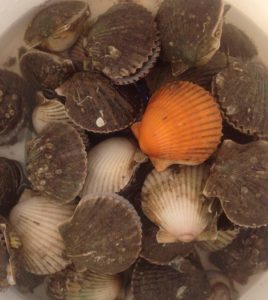Differences between Bay Scallops and Sea Scallops

Bay Scallop Anatomy
According to the Florida Fish and Wildlife Conservation Commision, the bay scallop is a member of the phylum Mollusca in the class Bivalvia. Bivalves have two valves, or shells, joined by a hinge. The bay scallop’s upper shell is a dark mottled color and its lower shell is typically white. Occasionally, both shells are bright yellow or orange, but these individuals are rare.
Sea Scallop Anatomy
Based on NOAA Fisheries, Scallops are bivalves (having two shells), like clams and oysters. Sea scallop shells are smooth and lack the prominent ribbing that is characteristic of most other scallop shells. It is thought that the sea scallop’s smooth shell is an adaptation to allow it to propel itself faster and farther.
Differences:
The size is one of the largest distinctions. Bay scallops can reach a shell height of 90 millimeters (3.5 inches) and live up to two years; sea scallops can be up to 3 times larger. Due to their small size, bay scallops cook very quickly.
Where to find them: The Florida Bay Scallop grows and lives in seagrass beds in shallow water (normally 4-10 feet deep). Sea scallops live in the deep cold waters on the ocean floor.
What do Bay and Sea Scallops eat? Bay scallops feed by opening their shells and filtering small particles of algae and organic matter from the water. Sea scallops eat anything that drifts: krill, microorganisms, algae, flagella and larvae, including scallop larvae. Sea scallops use built-in siphons to pull water over mucous membranes that trap the plankton and then hair-like scilia transfer the trapped food into the scallop’s mouth.
Reproduction: In the final stages of development, scallops use all their energy for reproduction. Rapid changes in water temperature generally trigger bay scallops to spawn. In Florida, most spawning occurs in the fall when the temperature drops. A single scallop is capable of producing millions of eggs at once, but only one egg out of 12 million is likely to reach adulthood. It takes approximately 36 hours for fertilized eggs to become tiny larvae, known as veligers.
Life span: Sea scallops can live up to 20 years. They grow quickly for the first few years of their life. On the other hand, Bay scallops can live up to two years. In Florida, however, bay scallops rarely grow larger than 75 millimeters (3 inches) or live longer than one year.
Florida Scalloping Trips
Scallop season 2020 runs from early June to late September. You can snorkel underwater and search for bay scallops. Direct transit of legally-harvested bay scallops is allowed through closed areas. Come to have some fun with your family and friends, contact My Fishing Buddy Charters for more information at (352) 812-3318.
